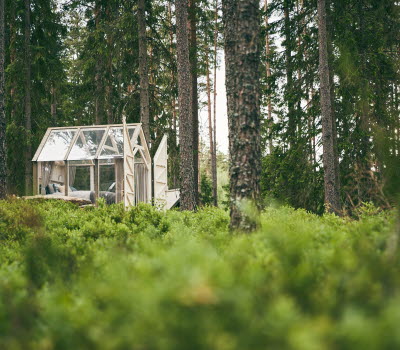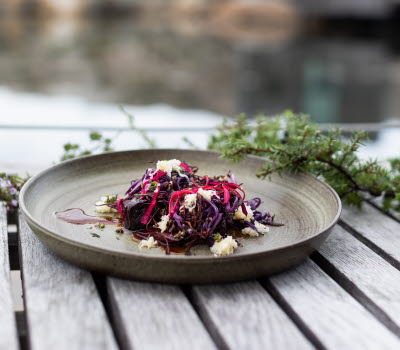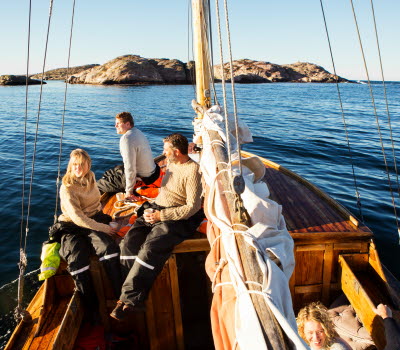Blue food – Sustainable food from Swedish waters
There’s an increasing interest in blue food from the sea. Mussels, oysters, sea squirts, seaweed and aquatic plants are trendy and climate conscious ingredients, served frequently in seaside restaurants around West Sweden. You can learn more about which species, and where to enjoy them, here.
The waters off the Bohuslän coast in Sweden are like a giant treasure chest, at least when we’re talking about food. More and more restaurateurs and producers are getting inspired by sustainable sea sourced ingredients, and there’s a lot of potential when it comes to environmental considerations and new taste experiences.
What is blue food?
Blue food refers to ingredients with an aquatic origin, which includes the sea and lakes. Another name for it is seafood or aquatic food. Some well known examples of blue food are mussels, oysters and seaweed. There are also some we’re less familiar with, like sea cucumber, swimming crab, glass shrimp and sea squirt.
Photographer: Madeleine Landley
How is blue food sustainable?
If it’s properly produced, food from the sea is a lot more eco-friendly than red meat. Shellfish help to keep oceans clean. Did you know for instance that a single mussel can filter up to five litres of water per hour? Organic production systems help to reduce eutrophication (nutrient over-enrichment) of the fjords in Bohuslän. Seafood doesn’t require fodder production either, but it does need to be harvested in the right way and many Swedish businesses are at the forefront when it comes to that. Unfortunately there are still lots of large operators in other countries bottom trawling from the seabed, which damages the marine ecosystem.
Food from the sea, moreover, is really good for you; it’s low in fat and at the same time rich in proteins, vitamins and minerals.
Blue mussels from Bohuslän
In the Swedish region of Bohuslän, blue mussels are farmed using the longline method. Free swimming mussel larvae attach themselves to ropes, where they feed on phytoplankton and develop into mature mussels which are ready to be harvested after 15 months. Bohuslän’s blue mussels, encouragingly, have received EU protected designation of origin (PDO).
There has been a marked increase in demand for blue mussels over the last decades, and dishes like Moules marinières and Moules frites have become classics in West Swedish restaurants.
Businesses working with blue mussels:
• Musselbaren Ljungskile
• Musselbaren Smögen
• Lysekils ostron & musslor
Oysters
The Swedish west coast, in particular the archipelago around the coastal town of Grebbestad, has the optimal conditions for oysters. The waters here are cold and clean, with a high salinity. The oyster variety Ostrea Edulis, harvested in the wild here, has been granted an EU PDO under the name Grebbestad oysters.
But it isn’t just the water that is important for oysters to thrive. Each oyster is cleaned and hand harvested by divers or fishermen equipped with landing nets, aquascopes and waders – a craft that requires both time and expertise.
There are both wild and farmed oysters. Crassostrea Gigas, also called the Japanese oyster, is one of the world’s most farmed oysters. This oyster variety is native to the Pacific coast but is today common in both Swedish and European waters.
Businesses working with oysters:
• Everts Sjöbod
• Klemmings Ostron
• Havstenssunds Ostron
Seaweed and algae
Grass kelp, bladder wrack, sugar kelp and sea lace. For over 4000 years varieties of seaweed have been important ingredients in Japanese cuisine, but for us here in Scandinavia, seaweed and algae are relatively seldom seen on the plate. Luckily this nutritious plant species has had a bit of a boom in the last few years and interest just continues to rise. Most species are perennial (some can live up to 30 years) so as long it’s harvested carefully, seaweed can be an incredibly sustainable ingredient that benefits from the sea's nutrients and at the same time can help offset acidification.
There are no poisonous varieties of seaweed in Swedish waters, but some are better ingredients in cookery than others. They can be used as flavouring, as a vegetable, in salads, and can be boiled, fried, dried and pickled.
Businesses working with seaweed:
• Catxalot
• Ten Island Seafarm
Sea squirts
Sea squirts are likely to be unfamiliar to most of us, but in fact there are 1,850 different species of sea squirt around the world, and 20 of them can be found in Swedish waters. What is sea squirt then? Well it’s a spineless sea creature related to corals and mussels, which lives on the sea bed. They look like greyish narrow tubes, about the same size as a finger. Sea squirt can be farmed in the same climate smart way as mussels and also helps to keep seas clean and reduce eutrophification.
Photographer: Roger Borgelid
Will we see more blue food on our plates in the years to come?
Absolutely! There’s a lot of research going on around Sweden into food from the sea, and the vision is to make this country a leader in sustainable seafood. This means that we have to become better at using the whole edible product, not just the best bits. We also need to widen the range, and look at more species than are used today, both so that there will be enough food for a growing population, and because it’s not sustainable to only eat a few species.
The Swedish west coast clearly has an important roll to play, and happily there are many talented business owners and chefs in the area playing an active part in tempting more guests to try new tastes, by coming up with innovative and exciting dishes.
Photographer: Ulf Svane Photography
















